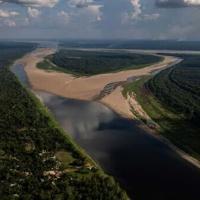Carrying six-liter bottles of water on their shoulders, members of Colombia’s Indigenous Yagua community march along the dried-up riverbed of a branch of the Amazon.
In the Three Frontiers region, where Colombia borders Brazil and Peru, the flow in some areas of the world’s largest river by volume has decreased by 90 percent, creating a desert of brown sand with ripples.
Near the Colombian border town of Leticia, the 600 residents of a Yagua village now overlook a kilometer-wide (.6-mile) beach that has appeared out of nowhere.
Just three months ago, before the smaller branch of the Amazon near Leticia dried up, villagers only had to travel about 15 minutes to reach the riverbanks.
Now, under the scorching sun, they have to walk for two hours to reach the docks where boats bring supplies on the only route in and out of the jungle.
“This is a very challenging time,” said Victor Facelino, a 52-year-old Yagua man as he carried a water container back home, given by the government to help provide water for those living in the world’s largest rainforest.
“Sometimes we get stuck in the sand,” he added, out of breath.
Colombia’s National Unit for Disaster Risk Management (UNGRD) attributes the dramatic shrinkage of the river in the Three Frontiers region to the worst drought the Amazon has experienced in nearly two decades.
“For many of these communities, the river is their only means of transport, and with the drying up of the tributaries, they are completely cut off,” said UNGRD director Carlos Carrillo.
– ‘Like before’ –
The governor of the Colombian department of Amazonas, a 109,000-square-kilometer forest area, described the drought as the “most severe climate crisis” ever seen in the region.
This coincides with the worst wildfire season in the Amazon in nearly 20 years, according to Europe’s Copernicus climate observatory.
On the Peruvian side of the border, several towns are facing food shortages.
In Brazil, where the Amazon is suffering from fires, authorities have declared a “critical situation,” with low water levels at a hydropower station that generates 11 percent of the country’s electricity causing concern.
The logistical challenges have caused the prices of basic goods, including fuel, to skyrocket. Fishermen now have to travel further upriver to catch fish.
“Everywhere you go by the river, it’s dry,” complained Roel Pacaya, a 50-year-old fisherman in the town of Puerto Narino.
Maria Soria, a Yagua woman who sells handicrafts on Monkey Island in the Colombian Amazon, is worried that soon “the entire river will begin to dry up.”
“I pray to God to change things back to how they were before, so we can live as we used to,” she said, wearing a traditional blue-feathered headdress and chest covering of palm fiber while dancing for a small group of tourists.
– Going with the flow –
For those who still have access to the river, life isn’t easy.
Eudocia Moran, 59, feels trapped by the stagnant waters of the Amazon that lie just meters from her home.
Trips to Leticia, about 30 miles down the river, have become less frequent as boat operators fear getting stuck in the sand.
Moran, a leader of the Ticuna Indigenous community, believes the solution lies in returning to agriculture.
She advocates for relying less on tourism and focusing more on farming to survive.
In a garden irrigated by a small section of the river, she grows cassava, beans, corn, and fruit.
“We must adapt to the times and learn to live with the changes,” she said.
das/lv/cb/nro





